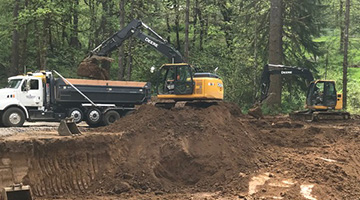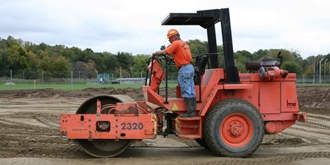Dump Truck Companies in Ohio - Trustworthy Dump Truck Providers Throughout Ohio
Dump Truck Companies in Ohio - Trustworthy Dump Truck Providers Throughout Ohio
Blog Article
Comprehensive Excavation Approaches: Grasping the Fundamentals for Success
In the realm of building and civil engineering, the relevance of efficient excavation approaches can not be overstated. The cautious planning, precise execution, and careful focus to detail needed in excavation jobs require an extensive technique that encompasses various essential facets. From first soil analysis to the application of security procedures and normal progression monitoring, mastering these core elements is important for attaining success in any kind of excavation endeavor. The real proficiency exists not just in understanding these fundamentals however in perfectly integrating them to browse the complexities of excavation projects with finesse.
Recognizing Excavation Task Planning

The initial phase of any kind of excavation job is the planning stage, where essential choices are made that can significantly influence the result of the project. Understanding the project budget plan, extent, and timeline constraints is vital for developing a comprehensive excavation plan that makes sure the job's success.
One trick facet of excavation project planning is the advancement of a comprehensive timeline that details the series of turning points, deadlines, and activities. This timeline acts as a roadmap for the job group, permitting them to track progression and make needed modifications to guarantee the project remains on timetable. Furthermore, a well-defined spending plan that makes up all costs, including devices leasing, labor expenses, and products, is essential for avoiding price overruns and delays. By carefully taking into consideration all these aspects throughout the drawing board, excavation projects can be implemented effectively and efficiently, leading to effective outcomes.
Soil Evaluation and Site Examination
Performing comprehensive soil evaluation and site analysis is a crucial action in the prep work stage of any excavation job. Dirt evaluation entails identifying the structure, framework, and residential or commercial properties of the dirt at the excavation website. This details is crucial for understanding the soil's bearing capability, wetness material, and potential for erosion, which are essential aspects in establishing the excavation methods and equipment needed for the project.
Site evaluation goes beyond soil analysis and encompasses a broader assessment of the overall site conditions. This evaluation includes identifying any potential hazards, such as underground utilities, environmental concerns, or unsteady terrain, that could impact the excavation process. By thoroughly assessing the website, task supervisors can create reliable excavation strategies that focus on safety and security, performance, and environmental management.
Making use of sophisticated innovations like ground-penetrating radar, soil sampling, and drone surveys can enhance the accuracy and performance of dirt evaluation and site evaluation. Spending time and sources in these initial steps can eventually conserve time and protect against costly hold-ups or complications during the excavation process.
Tools Selection and Use
Efficient excavation projects count heavily on strategic tools choice and utilization to make certain ideal efficiency and efficiency. Selecting the ideal equipment for the work is critical in optimizing performance and minimizing downtime. Variables such as the kind of soil, deepness of excavation, and project extent play a significant duty in establishing the most suitable equipment for the job at hand.

In addition to selecting the suitable devices, correct usage is crucial to job success. Operators needs to be educated to handle the devices safely and efficiently - septic ohio. Normal upkeep checks and timely repair services aid stop malfunctions and make certain constant performance throughout the project
Safety Actions and Rules Conformity
In the realm of excavation projects, prioritizing precaution and conformity with guidelines is critical to guaranteeing a legitimately audio and protected operational environment. Safety and security procedures encompass a range of techniques, including conducting detailed website analyses, carrying out proper signs and barriers, and providing sufficient safety and security training for all employees associated with the excavation procedure. Adherence to policies, such as OSHA requirements in the USA, guarantees that the excavation project fulfills the necessary criteria to secure workers, spectators, and the surrounding environment.

Monitoring Progression and Adjusting Methods
How can forecast supervisors efficiently track the development of excavation tasks and adapt their methods accordingly to enhance end results? Monitoring development is crucial for guaranteeing that excavation tasks stay on track and satisfy target dates.

Conclusion
Finally, understanding the principles of detailed excavation methods is important for the success of any type of project. By comprehending task planning, assessing soil and site problems, selecting suitable tools, abiding with safety guidelines, and keeping track of progression, project supervisors can guarantee a smooth and reliable excavation procedure. Executing these approaches will certainly cause effective outcomes and minimize prospective risks or setbacks throughout the excavation job.
The first stage of any type of excavation job is the planning phase, where critical choices are made that can dramatically affect the outcome of the project. Comprehending the YOURURL.com job scope, timeline, and spending plan constraints is important for producing a detailed excavation plan that guarantees the task's success.
How can predict supervisors successfully track the advancement of excavation tasks and adjust their methods as necessary to enhance outcomes? By closely keeping an eye on development and being eager to adjust methods, project managers can enhance the total success of excavation tasks.
By understanding task preparation, analyzing dirt and site conditions, selecting ideal tools, complying with safety and security Web Site guidelines, and checking development, job managers can make sure a smooth and reliable excavation process.
Report this page